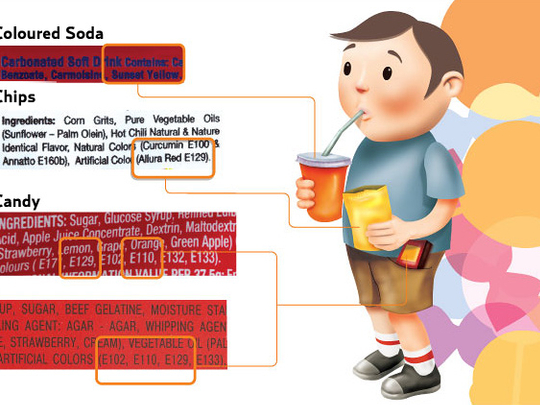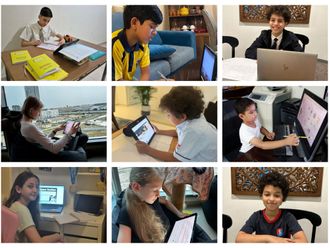
When Zayed University student Latifa Al Mazroui decided to look into the prevalence of artificial food colourants in Abu Dhabi shops she imagined that 10 per cent of products she audited would contain them at the most.
However, she was shocked to discover almost half of the children's snacks she audited contained artificial food colours that are either banned or restricted in the United Kingdom and European Union.
In her capstone project entitled The Southampton 6 and Hyperactivity: A food retailer and lunchbox audit, she looked at six colour additives, known as the Southampton 6, found in crisps, fizzy drinks and sweets.
The Southampton 6 additives — Tartrazine (E102), Quinoline Yellow (E104), Sunset Yellow (E110), Carmoisine (E122), Ponceau Red (E124), Allura Red (E129) — have been found to cause serious health and behavioural problems in children.
Her study also looked at how much of these additives children were consuming because colour additives are mainly found in children's snacks and drinks. She examined the food wrappers found in lunch boxes of nine children between the ages of eight and 14 over a three-day period.
Research has linked colour additives to hyperactivity as well as respiratory, skin, gastrointestinal, and neurological symptoms.
In April 2008, a group of researchers estimated that 30 per cent of cases of attention deficit hyperactivity disorder (ADHD) would be prevented if food manufacturers removed the artificial food colours used in the global additives industry.
Findings
Of the 515 products child-orientated products that Latifa audited 223, 43 per cent, contained one or more of the Southampton 6 colours.
A high percentage of the colourants were found in sweets, crisps and fizzy drinks. "Sweet products did not only contain one colour of the Southampton 6 but some products contained a combination of them," said Latifa who named several well-known products that are internationally known.
She got hold of sweet wrappers of the same products in the UK and Europe and found that the potentially harmful additives were absent.
This is because of the different regulations that manufacturers abide by from country to country and a product's actual ingredients will differ based on the country in which it is sold.
Fizzy drinks also contained multiple colour additives. Crisps contained the lowest amount as natural spices were used to flavour and colour the products.
Lateefa said it was also surprising to see the additives in common food products you wouldn't expect them to be in such as fruit juices, cheeses, butter, hotdog casings and skins of fruits.
When Latifa assessed the contents in the lunch boxes she found that not a single day had passed without the children consuming a product with additives from Southampton 6. On an average children were eating snacks with additives about 15 times a day.
Daily exposure
"This is extremely shocking and worrisome because we still don't know what are the long-term effects of the daily exposure to these colours; but we surely could deduce from previous published studies that they are of great seriousness. Sunset Yellow was the most consumed additive.
"Children are over-consuming these colours and are eating them on a daily basis. This calls for the need for future studies that would examine the effects of these additives within the UAE population and that would assess its future health complications," Latifa said.
She also believes that it is important to increase awareness concerning the consumption of food colour additives and their negative health impacts through educational programmes targeted at parents as well as children. She said the Joint Food and Agriculture Organisation and World Health Organisation (FAO/WHO) Expert Committee on Food Additives strongly recommends that governments periodically check the total intake of each and every food additive, especially those that may pose a potential hazard if their total intake exceeds allowed levels based on dietary studies at national levels.
It is also up to consumers to read labels carefully and be wary of food products that look too bright and colourful. "Television advertising that promotes artificially coloured food products that encourages children to buy and eat unhealthy junk food should be vigorously cut down and regulated as children are presently surrounded by images promoting extremely unhealthy eating habits," she said.
Every country has its own food colour additive regulations, which is why acceptable colour additives vary greatly based on government legislation and standards of what ingredients companies could include in their products, Latifa said.
In the UAE two colours of the Southampton 6 are banned which are Quinoline Yellow and Ponceau Red due to their toxic and carcinogenic effects. Carmoisine and Allura Red are only banned if they are included in jams so that consumers won't be deceived by the product's bright red colour thinking it's of superior quality compared to other brands.
Not all countries are convinced of the health dangers that colour additives pose despite new legislation in the UK and EU to restrict or ban them. In Turkey Ponceau Red, Allura Red, Sunset Yellow, Tartrazine, Quinoline Yellow and Carmoisine are allowed, among others.
The US's Food and Drug Administration allows Allura Red, Tartrazine and Sunset Yellow while Australia and New Zealand allow all six of the Southampton 6 additives.
In an interview that Latifa conducted with Khadeeja Al Shkaily, head of vitamins and additives department at the Abu Dhabi Food Control Authority (ADFCA) laboratories, she said that ADFCA along with the Health Authority had previously declared that there aren't enough studies that validate the harmful effects of permitted colours.
She also said that if other countries banned these colours it doesn't mean that they should do the same without conducting fundamental studies.
However, a 2006 study in Kuwait showed that the consumption of artificial food colour additives of an age group ranging between five and 14 exceeded the recommended level of acceptable daily intake set by the FAO and WHO in 1999.
"By the results of this study we could interpret that the same problem persists in children within the UAE since we share the same food eating practices and habits as other GCC countries," Latifa said.
Attempts to get comment from the UAE Ministry of Environment and Water were not successful.
The Southampton 6 colour additives
Over the years medical experts have suggested that artificial food additives and colourants affect children’s behaviour.
Research has linked colour additives to hyperactivity, which increases behaviours such as lack of concentration,lack of focusing, interrupting conversations, talking too much and fiddling with objects. Additives found in food was also found to induce respiratory, skin, gastrointestinal and neurological symptoms.
In 2007, British medical journal The Lancet, published a study conducted by researchers at Southampton University, which found that several artificial colours and the commonly used preservative sodium benzoate used in foods and drinks are associated with an increase in hyperactive behavior in children.
Known as “The Southampton 6” the food colours Tartrazine (E102), Quinoline Yellow (E104), Sunset Yellow (E110), Carmoisine (E122), Ponceau Red (E124), and Allura Red (E129) were audited.
Three-year-old and eight to nine-year-old children participated in the study. The researchers found that certain mixtures of food additives, including artificial colours, can lead to an increase in hyperactive behaviours and over activity in some children.
The United Kingdom and the European Union have since established regulations on colour additives to foods. They have a strategic plan to force manufacturers who are using the Southampton 6 colours in their food products to include a statement that says “may have an adverse effect on activity and attention in children” on the product food label under European law. Artificial food colour additives are already phased out in some European countries.
In the UAE, only two colors of the Southampton 6 are banned which are E104 and E124 due to their supposed toxic and carcinogenic effect.
What to watch out for
Tartrazine E102
Is a synthetic lemon yellow azo dye, which is primarily used by the soft drink industry. It has been linked to negative health effects that cause allergies. Sensitivity and occurs mainly in asthma-sufferers or those sensitive to aspirin. Responses to the colourant may include anxiety, migraines, weakness, skin rashes, sleep disturbance, and clinical depression.
Quinoline Yellow E104
Is a synthetic coal tar greenish-yellow dye, which is found in lipsticks hair products, colognes, ices, cough sweets, scotch eggs, smoked haddock, and also in a wide range of medications. Quinoline Yellow has been linked to the development of dermatitis, hives and rhinitis.
Sunset Yellow E110
Is a synthetic coal tar and azo yellow dye and is found in orange jelly, marzipan, apricot jam, lemon curd, sweets, hot chocolate mix, packet soups, trifle mix, breadcrumbs, cheese sauce mix, soft drinks, fortune cookies, certain pound cakes,snack chips, and other yellow, orange, and red food products.
Consumption of Sunset Yellow has resulted in hives, rhinitis, nasal congestion, allergic reactions, abdominal pain, and nausea. In some scientific studies it has been linked to an increased incidence of tumours in animals and chromosomal damage, and it has also been found to damage kidneys and adrenals when fed to laboratory rats.
Carmoisine E122
Is a synthetic red food dye from the azo dye group and is used mainly in jams and preserves as well as sweets and soft drinks. It was found by the US Certified Colour Manufacturers
Association to be unavoidably contaminated with low levels of beta- napthylamine, which is a well known carcinogen; it has also been found to be mutagenic in animal studies.
Ponceau Red E124
Is a synthetic red azo food dye, it is used mainly in dessert mixes, jelly, salami, seafood dressings, tinned strawberries and fruit pie fillings, packed cake mixes, cheesecakes, soups and trifles. Ponceau has been found to exhibit a weak carcinogenic action. In addition, it appears to cause allergic or intolerance reactions particularly amongst those with an aspirin intolerance.
Allura Red E129
Is a synthetic red azo food dye, which is used in sweets, gelatins, puddings, biscuits, cake mixes, fruit flavoured fillings, drinks, medications and cosmetics. Allura Red has
been connected with cancer in mice. Allura Red may cause an adverse reaction in people with an aspirin intolerance or allergy. It’s also found to cause severe urticaria, nausea, difficulty breathing, anaphylaxis, and in rare cases acts as a system depressant.













